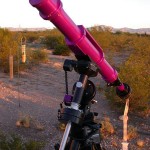
The lens triplet is exquisite, providing absolutely perfect airy disks at high power. The photo below shows an example of the out of focus image of Antares taken with the telescope. Pulling out my copy of Suiter’s Star Testing Astronomical Telescopes shows nearly identical images for the ideal diffraction pattern. No wonder the ‘scope won a RTMC merit award.
Photographically it has proven to be almost perfectly free of color, corrected across the spectrum. There do not seem to be any detectable UV or IR halos around bright stars. This is partly a result of good design, and aided by the long focal length of f/13. No field flattener is required, with pinpoint stars across the focal plane.
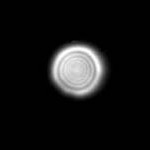
The tube Roger had mounted the lens set in was good for visual use, but not strong enough to support a heavy CCD or DSLR camera. Thus I set about machining a new tube for the scope. Cut from solid aluminum the frame is heavy and VERY solid, typical Cooper over engineering. Tube rings support a Losmandy compatible dovetail plate and an upper plate for mounting a guide scope or another camera. The rear sports a Feather Touch crayford focuser. Contrast is good thanks to a full set of baffles down the interior of the tube.
With the Losmandy compatible dovetail I can mount the tube on either the Losmandy G11, providing a tracking mount, or the smaller tripod build to accommodate Primero. The long tube requires a high mount to use comfortably. Fortunately the adjustable extensions built into the legs on the small tripod allow the mount to be raised nearly a foot.
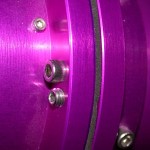
A few design details…
Shown to the right is a close photo of the collimation screws at the rear of the lens cell. Note the capscrew that serves as the ‘pull’ and the setscrew that serves as the ‘push’ in this traditional push-pull arrangement.
Also seen is the closed cell neoprene foam that seals the gap, but allows adjustment of the lens cell.
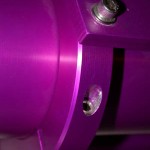
The tube started life as a 3.5″ ID x 4.0″OD 6061-T6 aluminum tube. This was machined down to 0.1″ thick along most of its length, but the ends were left near full thickness to allow mounting of the flanges for each end. The design would have been a little simpler if I could have machined a slightly longer tube. The bed of the lathe I had available would only accommodate a 36-inch long piece, and perhaps a bit more at a stretch. Thus I modified the cell and rear focuser mount designs to absorb a little of the tube length.
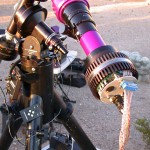
This tube was machined with the rest of the scope. When the focal point was calculated for use with a 2″ mirror diagonal the extension tube length was calculated to match. The tube length allows for the 46.5mm (1.83in) that a standard Nikon F-mount lens requires from the image plane to the lens mounting ring. Thus any film or CCD camera with the same back focus requirement will work. The back focus of a Canon EOS camera body is slightly different, 44mm (1.73in), a difference small enough to be compensated for by the focuser.

